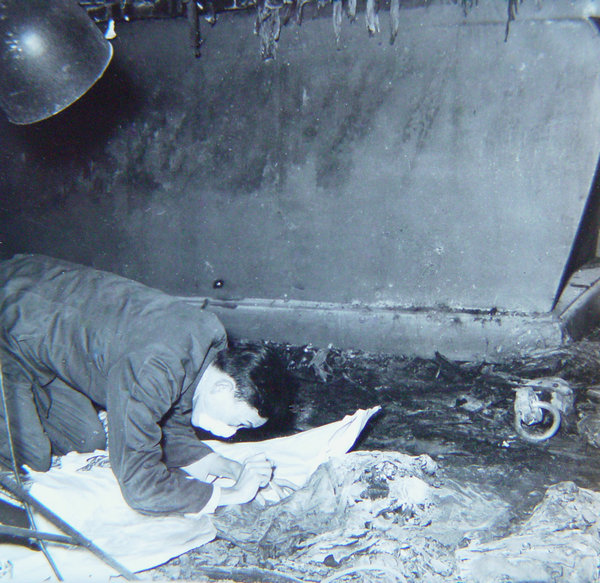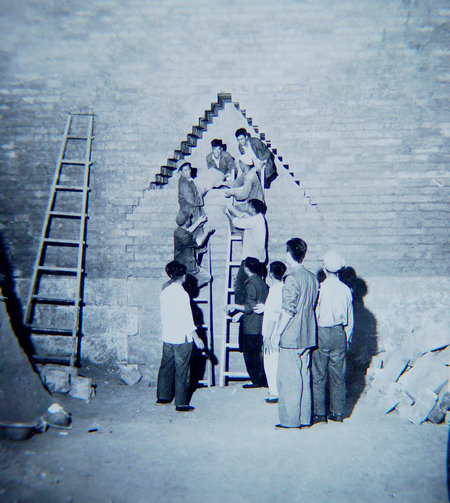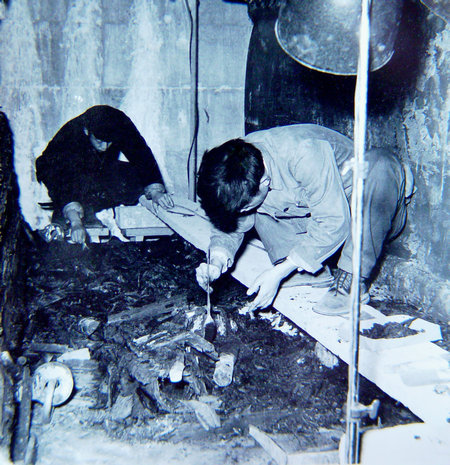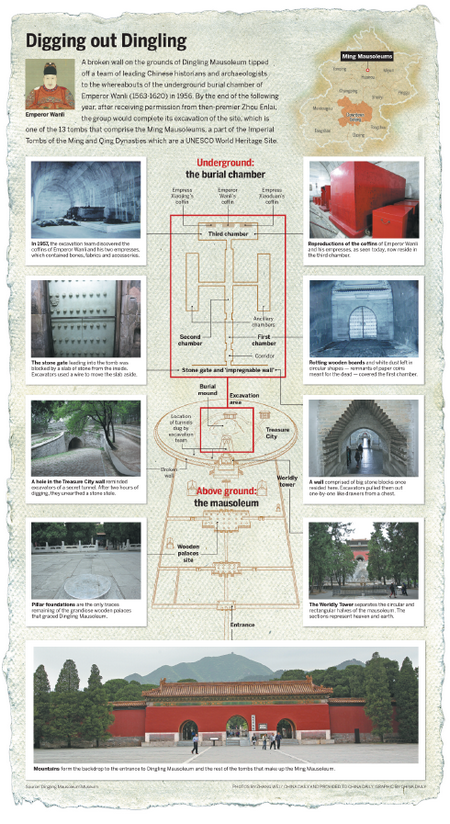
|
Archaeologists recording what they saw inside the Dingling Mausoleum's underground tomb in 1957. [Photo provided to China Daily] |
Sixty one years have passed, but Sun Xianbao well remembers exactly what he saw aftersqueezing himself through the narrow opening between two giant stone panels, panels that formthe gate to the burial chamber of Emperor Wanli (1563-1620)."On the ground were rotted wooden boards and some whitish circles," the 80-year-old says.
"The circles, it turned out, were the paper coins meant for the deceased. Time had turned thepaper into grainy dust."
In 1957, from where he stood, inside the tomb, Sun removed a rectangular stone slab that hadleaned against the panels and served as lock for 337 years.
Now the gate leading to the final resting place for the longest-reigning emperor of China's MingDynasty (1368-1644) was finally opened.

|
The opening of the Impregnable Wall. The man on top of the left ladder is ZhaoQichang. [Photo provided to China Daily] |
In the late 1980s Yang, together with Yue Nan, a historian, wrote the book Wind and Snow atDingling (feng xue ding ling), a vivid recount of the entire excavation process.
In the 1950s, when some leading historians and archaeologists in China decided to excavate animperial tomb from the Ming Dynasty for research, Dingling (1368-1644) was not even near thetop of the list, Yang says.
"They initially focused on other tombs, tombs either belonging to a historically more importantMing Emperor or standing the chance of housing crucial information, imperial tomes forexample."

|
Archaeologists clearing the coffins at Dingling Mausoleum. [Photo provided toChina Daily] |
They Hardly had the excavation team got down to work, than they realized they faced a giantconundrum, the answer to which the designers and builders of the mausoleums had triedeverything to hide. With no clues yielded by the ground of the tombs they were aiming for,frustrated members eventually decided to focus on any mausoleum that might give them a tip-off. That was when someone noticed a caved-in section on a wall surrounding the circularground that constitutes the second half of the mausoleum's design.
The entire layout of the mausoleum is split in two-a rectangular part at the front and a circularpart at the back, separated by a stone tower known as ming lou, or the Worldly Tower. Thedifferent shapes were meant to represent Earth and Heaven, believed by ancient Chinese to bein a square and a circle respectively.

|
Inside Emperor Wanli's underground tomb. [Photo provided to China Daily] |
The broken wall might be the place. And remember, this was in May 1956.
"The bricks had gone and there was a big hole about half a meter in diameter," Yang says. "Since it was three meters above the ground, the team members had to set up a human ladderto reach the hole and take a peek inside. It was a peek that would change the contemporaryhistory of the Dingling Mausoleum."
The rim of the hole appears to its examiners like the upper edge of an arched gate. Peekinginside, the man at the top of the human ladder also glimpsed brick marks-marks left on earthindicating the previous existence of bricks. What according to some villagers had been a hidingplace for local bandits reminded the archaeologists of the entrance to a secret tunnel.

|
Digging out Dingling. [Photo by Zhang Wei/China Daily] |
Difficult quest
So they began digging. Two hours later, a stone stele was unearthed bearing the characters suidao men, or tunnel gate. Ten days later, as the team arrived at 4.2 meters underground, theydiscovered brick walls on both sides of an 8-meter-wide path that ran along the circular wall ofthe Treasure City. In retrospect, the path, called "the brick tunnel" was the route the colossalcoffins of the emperor and his two empresses traveled after their arrival at the mausoleum.
However, a promising beginning did not lead to a quick ending. After digging for months andfinding nothing, the team jumped ahead and dug more along that same route, but still foundnothing.
"It seemed that they had assiduously followed this clue that rolled out before them like threadfrom a skein, only to arrive at the end and find nothing but the end of the thread. It was in July andAugust, with rainwater constantly filling the trench. Yet just when most people were about to giveup, the emperor, if you like, sent another beckoning."